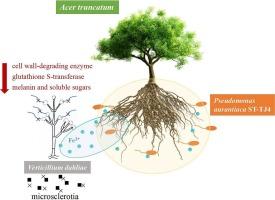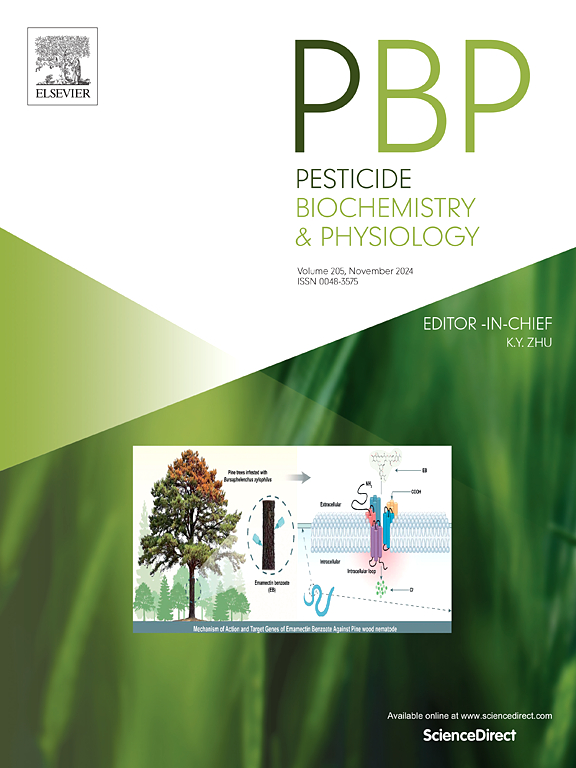Biocontrol activity and action mechanism of Pseudomonas aurantiaca ST-TJ4 against Verticillium dahliae, the causal agent of Acer truncatum wilt
IF 4.2
1区 农林科学
Q2 BIOCHEMISTRY & MOLECULAR BIOLOGY
引用次数: 0
Abstract
Acer truncatum wilt caused by Verticillium dahliae is a severe soilborne disease that poses a threat to the cultivation of this plant in China. The present study explored the biocontrol efficiency and underlying antagonistic mechanism of Pseudomonas aurantiaca ST-TJ4 against V. dahliae. In vitro, strain ST-TJ4 exhibited excellent inhibitory effects on V. dahliae, causing mycelial deformation. This strain significantly suppressed the production of V. dahliae conidia and microsclerotia. Moreover, the application of ST-TJ4 reduced the incidence of Verticillium wilt in A. truncatum saplings in both the prevention group and the cure group. Comparative transcriptomic analyses revealed that ST-TJ4 induced differential expression of numerous genes in V. dahliae, most of which were downregulated. These differentially expressed genes were associated with cell wall-degrading enzyme activity, sterol biosynthetic processes, glutathione S-transferase activity, iron ion and sugar metabolism, and oxidoreductase activity. Further transcriptomic analyses of physiological indices indicated that ST-TJ4 significantly inhibited the synthesis of pectin lyase, endo-β-1,4-glucanase, melanin and soluble sugars of V. dahliae and had a stronger inhibitory effect under iron deficiency. Taken together, these data highlight P. aurantiaca ST-TJ4 as a promising biocontrol agent against A. truncatum Verticillium wilt.

金假单胞菌ST-TJ4对槭枯病病原菌大丽黄萎蔫菌的防效及作用机制研究
大丽黄萎病(Verticillium dahliae)引起的槭枯病是一种严重的土传病害,严重威胁着中国槭的种植。本研究探讨了金假单胞菌ST-TJ4对大丽花弧菌的生物防治效果及其拮抗机制。在体外,菌株ST-TJ4对大丽花弧菌表现出良好的抑制作用,引起菌丝变形。该菌株显著抑制大丽花分生孢子和微菌核的产生。此外,ST-TJ4的应用降低了预防组和治疗组青杨幼树黄萎病发病率。比较转录组学分析显示,ST-TJ4诱导了大丽花中多种基因的差异表达,其中大部分基因表达下调。这些差异表达的基因与细胞壁降解酶活性、甾醇生物合成过程、谷胱甘肽s -转移酶活性、铁离子和糖代谢以及氧化还原酶活性有关。进一步的生理指标转录组学分析表明,ST-TJ4显著抑制大丽花果胶裂解酶、内切酶-β-1,4-葡聚糖酶、黑色素和可溶性糖的合成,且在缺铁条件下具有较强的抑制作用。综上所述,这些数据突出了P. aurantiaca ST-TJ4是一种很有前途的防治黄萎病的生物制剂。
本文章由计算机程序翻译,如有差异,请以英文原文为准。
求助全文
约1分钟内获得全文
求助全文
来源期刊
CiteScore
7.00
自引率
8.50%
发文量
238
审稿时长
4.2 months
期刊介绍:
Pesticide Biochemistry and Physiology publishes original scientific articles pertaining to the mode of action of plant protection agents such as insecticides, fungicides, herbicides, and similar compounds, including nonlethal pest control agents, biosynthesis of pheromones, hormones, and plant resistance agents. Manuscripts may include a biochemical, physiological, or molecular study for an understanding of comparative toxicology or selective toxicity of both target and nontarget organisms. Particular interest will be given to studies on the molecular biology of pest control, toxicology, and pesticide resistance.
Research Areas Emphasized Include the Biochemistry and Physiology of:
• Comparative toxicity
• Mode of action
• Pathophysiology
• Plant growth regulators
• Resistance
• Other effects of pesticides on both parasites and hosts.

 求助内容:
求助内容: 应助结果提醒方式:
应助结果提醒方式:


